Chasing the light
From the Winter 2014 Issue
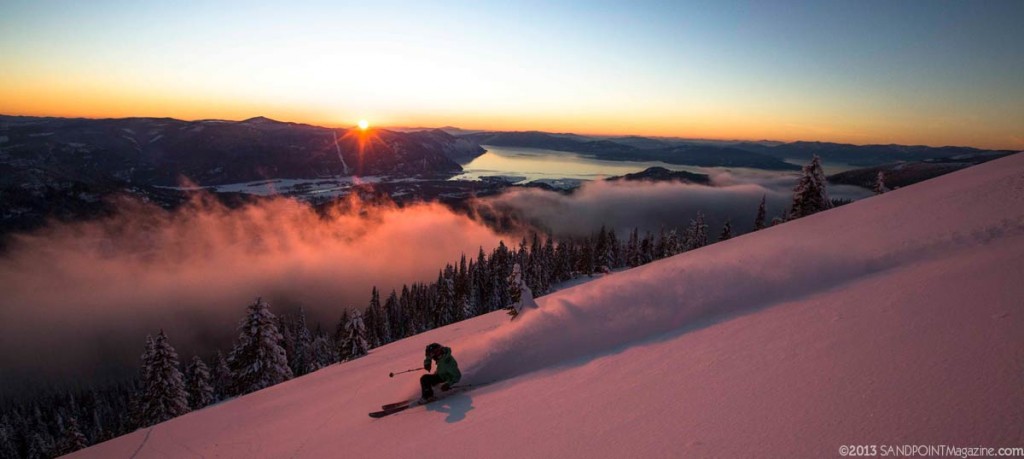
Area native and adventure photographer Patrick Orton only got 24 years on this Earth. He spent those years determined to ‘live life to the fullest.’
The four young men woke at 2 a.m. It was all about getting good light.
They left Sandpoint in a shroud of darkness and drove an hour and a half to Mosquito Creek Road in the Cabinet Mountains, where they parked their truck and unloaded snowmobiles. It was a Wednesday last January, cold and frosty. A milky layer of clouds hovered in the sky, but stars shone above, promising a clear, sunny day.
Earlier, they had done a reconnaissance mission and scouted their route, so this morning, they moved with the swiftness of men on a mission. They sledded in for two miles, then ditched their snowmobiles and began to skin uphill on skis toward the summit of 7,009-foot Scotchman Peak, the highest point in Bonner County.
They climbed for four miles and 3,500 vertical feet uphill. When they reached the summit several hours later, the rising sun was barely cresting the horizon. The light shined rose-tinted and flawless, just how photographer Patrick Orton intended it.
As they skied boot-deep powder down neighboring Goat Mountain, then climbed back up and skied Scotchman Peak, Patrick snapped photo after photo of his friends against a backdrop of Lake Pend Oreille, the Clark Fork River and a bursting raspberry sky.
Toward the end of the day, they built a jump on the bottom flank of the mountain. Orton’s three friends – snowboarder Elliot Bernhagen, the photographer’s travel partner for the last five winters, and Montana-based skiers Matt Stott and Carl Arnatt – hit the jump repeatedly, while Orton positioned himself behind the lens.
Orton, a Sandpoint area native, wouldn’t give up until he captured it just right. Eventually the sun began to set, glowing orange and hazy.
“I’ve been traveling to Colorado and British Columbia and Utah and Montana and never even realized the potential of my own backyard,” Patrick said last summer. “There’s so much potential and it’s right here. It’s mind blowing.”
That night, they didn’t get home until 7:30 p.m., 17 and a half hours after they had left. It was the kind of day Orton lived for.
The photos he snapped that day don’t just capture a moment in time; through their movement, energy, and blazing, earthly colors, they embody a life in the making.
They also symbolize a life cut tragically short.
On Friday, July 19, Orton, 24, was out late with friends, enjoying a few drinks during a summer night in Sandpoint. Walking toward City Beach at 2 a.m. to go hang out under the stars, Orton decided to jump into Sand Creek from the Bridge Street Bridge, something he had done countless times before.
But this time, something went horribly wrong. Orton stood on top of the bridge’s railing, 17 feet above the water, took off his shirt, and front flipped into the creek, a soaring leap of faith into the darkness.
He never came up for air.
Patrick Ryan Orton was born at home in Hayden Lake, Idaho, on Oct. 16, 1988, the second son of George and Kristina Orton.
A year later, the Ortons, including eldest son, Liam, moved to Sagle, where they purchased 20 acres of land at the base of Gold Mountain. They built a garden and started constructing their family home from scratch.
As a kid, Patrick was a wanderer. His mother, Kristina, had been raised on Great Britain’s Isle of Man and had been given great freedom as a child, so she afforded her boys the same. “Patrick would go hiking with his brother and they’d just take off through the hills,” Kristina said. “Whenever I felt like I was lost on the trails near our house, Patrick would always say, ‘I know where we are, Mom.’ ”
Patrick went on to play traditional sports like soccer, baseball and tennis, besides the family tradition of ping-pong, but it was in the mountains that he felt the most at home. A Boy Scout in his youth, he took avalanche safety and backcountry first-aid courses as a teenager, and he was on Shep Snow’s Independence Race Team at Schweitzer.
He was hitchhiking to Schweitzer as a teenager when Montana native Matt Stott, who was in his mid-20s at the time, picked him up. The two became friends and ski partners, and Stott started teaching Patrick how to backcountry ski. He was a quick learner and skiing unbridled terrain soon became an obsession for him.
“Skiing is one of the most liberating and creative things I have ever done,” Patrick once wrote.
When Patrick was 16, Kristina asked Sandpoint photographer Chris Guibert to shoot a picture of her son skiing, and it triggered an interest in Patrick. He started assisting Guibert, and he got his own camera gear and began shooting his friends on the mountain.
Patrick was never destined to have an ordinary desk job, and everyone around him could sense that. “Since a very young age I have felt a deep, indescribable drive to be outside playing in nature,” Patrick once wrote. “This quickly led me to the conclusion that I wanted to spend my life exploring this giant playground we call Earth.”
His parents say he was always curious and hungry for knowledge but not in a bookish sense. “Life’s for living and not for sitting around reading books,” Patrick would say.
Whatever skill Patrick attempted, he mastered it quickly. At age 15, his mom gave him a didgeridoo for Christmas. He had no idea how to play the Australian wind instrument, but soon after, he was at a festival in Seattle and he met a man selling didgeridoos who taught him circular breathing. He played the instrument for friends out on the lake constantly after that.
Much of his time growing up was spent helping his family maintain their property. He and his dad, George, would spend long days cutting timber and building frames for their barn, and eventually, a handsome log cabin on their land. “He worked right with me,” George said. “Patrick was very strong, very capable and he always had a vision. He just enjoyed creating and making beautiful things.”
At 16, Patrick used the family’s Bobcat to construct a 10-foot tower of rocks on the driveway leading up to their house. Building rock cairns became a trademark for him after that; he would stack up piles of stones on hikes, and he built a 4-foot cairn at the top of the downhill mountain bike course he constructed on Gold Mountain.
His rock sculpture on the driveway still remains today, nearly a decade later. Over the years, it has stood tall and strong, unwavering in the face of wind, rain and snow.
After graduating from Sandpoint High with high honors in 2007, Patrick moved to Glenwood Springs, Colorado, where he enrolled in the photography program at Colorado Mountain College, the same program that his mentor Chris Guibert had gone through.
It was there that he met his friend Elliot Bernhagen. For the next five years, they bounced around Colorado, Montana, Canada, Idaho, Alaska and beyond in wintertime. Three years ago, the two of them bought a pop-up Palomino camper for $1,000 for the back of Bernhagen’s Ford F-150. On social media, they called their travels in that tiny, mobile space #twodudesonecamper.
Patrick got his degree in two years and soon after, his photography career started to take off. Magazines like Outside, National Geographic Adventure, Powder, Freeskier, Rock and Ice, and others published his photos, and he got hired for commercial shoots with clients in the ski and outdoor industry.
He shot surfing in Indonesia, rock climbing and BASE jumping in Thailand, skiing in Revelstoke, wakeboarding in Idaho, and once, a sailing company flew him to Panama to shoot some gorgeous girl on a giant yacht.
“
He had that blind ambition that I recognized in myself before I was humbled,” said pro skier Lynsey Dyer, who met Patrick while skiing Mount Shasta last spring. “He was the first one to jump off the bridge after our big ski mission, he was the first to get out on sleds in Haines even though conditions were tricky. He was wildly ambitious.”
During the Salt Lake City Shootout in 2012, a ski photo contest, Patrick was paired with pro skier Nat Segal and a few others. They met at Utah’s Little Cottonwood Canyon at 4 a.m. so they could hike up in time to shoot Mount Superior at sunrise.
“Patrick was an incredibly hard worker,” said Segal. “We were firing out back-to-back shots, hiking nonstop until the sun had cleared the horizon. I had never worked so hard for a photo in my life, but it seemed like a normal day for Pat.”
He was admittedly a perfectionist when it came to his photos. Once, at a waterfall in Oregon, Patrick was behind the lens while a friend jumped an 80-foot cliff into the water. Patrick missed the shot. “Can you do it again?” he asked his friend. He ended up making the guy jump three times in order to nail the shot.
This past winter, Patrick and Bernhagen spent January exploring Idaho, plus a week in Jackson and several days at Outdoor Retailer in Salt Lake City. February took them to British Columbia to explore the backcountry around Revelstoke. March 1, they drove north to Alaska, covering thousands of miles and blowing an alternator just south of the Yukon. For the next three months, they plugged their camper in behind a lodge called the Funny Farm, 33 miles from the heli-ski mecca of Haines.
Four pro skier girls from Europe, including filmmaker and skier Sandra Lahnsteiner, rented a cabin at the Funny Farm. They were there to film a women’s ski movie. When they met Patrick and heard he was a published photographer, Lahnsteiner said: “We have an empty seat in the heli. Wanna come?” He spent six days shooting from a helicopter with some of the world’s best female skiers.
That was simply the kind of thing that happened to Patrick.
In a recent issue of The Ski Journal, which arrived in mailboxes less than a month after Patrick died, there’s a photo of Bernhagen, taken in Haines in late April. Bernhagen is looking up at the sky, arms wide open like wings, as a monsoon of snowflakes float down from above. It’s Patrick’s photo, of course, and it’s strikingly beautiful, the kind of image that makes you stop flipping pages and just stare.
“After all the guests had left and the heli season was over, I awoke to a blizzard,” Patrick writes about the photo. “With no one else around, (we) laughed as we watched massive flakes plummet from the sky, knowing that we were getting one last reset.”
One night in Haines, the northern lights appeared in the midnight sky. “We were in the camper asleep and Patrick went outside and there were northern lights,” said Bernhagen. “Patrick starts screaming and wakes up the whole lot to see the lights. He described that week as the best week of his life.”
At the end of the winter, Patrick had hundreds of images that he put together into a portfolio, all from one season. This summer, he and a friend road tripped through Southern California, stopping at the Powder magazine office to meet Powder’s longtime photo editor, Dave Reddick, and show him his portfolio.
A couple of months later, after hearing about Patrick’s death, Reddick went back through Patrick’s images. “Damn, if he doesn’t have a couple of real gallery-worthy shots and maybe a photo annual one, too,” Reddick said. “He really was arriving at a higher level with his work and coming into his own photographically.”
It was all part of the big picture for Patrick, a life plan he had been scheming for years. “Patrick’s goal was to become the best adventure photographer in the world,” said his high school friend Nate Bessler. “He was already breaking onto that scene, and he was only 24.”
Back home in Sandpoint this summer, Patrick worked and played for ridiculously long hours, seemingly never sleeping. He would load up his truck with firewood for a bonfire and kayaks and head to the lake, telling his mom, “I’m off to work.”
“You call that work?!” she would joke.
He also helped out aspiring young photographers, including 16-year-old Savannah Pitts, in the same way Chris Guibert had done for him. One of his former mentees was Jasper Gibson, a fellow Sandpoint native four years younger than Patrick. Patrick taught Gibson the foundations of photography, about composition and framing a shot.
“He wanted to inspire people with his images,” Gibson said. “He’d paint a picture in his mind and then he’d set it up just how he wanted it.”
Patrick once wrote, “I now cannot help but see the beauty of the world in details, composition and light.”
His camera became an extension of himself. “The images I create are a window for others to view my world,” Patrick wrote. “They allow me to show people a unique perspective on how I choose to live my life.”
“He loved how the light would transform a setting,” said his dad, George, pausing and then adding, “Patrick was the light of our lives.”
For the past two summers, Patrick lived with his parents in Sagle. He would tell them stories of jumping Char Falls, a 40-foot cliff, into a 10-foot wide pocket, and his mother, worried, would say, “Why do you have to do that?”
“I’d rather live life full-on than do anything halfway,” he would respond.
“Everything he did in his life was so intense,” said his childhood friend Jonathon Compton, who recently named his newborn daughter after Patrick. “He packed 100 years’ worth of life into his 24 years. He was like a can of frozen orange juice without any water. His life was highly concentrated.”
Five days before he died, Patrick was out rock climbing with friends above Lake Pend Oreille. Kristina and George paddled their kayaks out to watch them. Patrick got to the top of a climb, the pinnacle of a jagged rock face, and did a front flip into the water. He tumbled with the grace of a gymnast.
“What’d you think of that, Mom?” he asked her about the jump.
“The mother in me wants to say, ‘Patrick, don’t do things like that,’ ” Kristina said. “But it’s also really beautiful.”
“I thought that he really pushed the limits,” said George. “He would look at something, and say, ‘I could do that,’ while I’d look at it and say, ‘That’s dangerous.’ But he was very skilled and it’s amazing all the things he did.”
The day he died, Patrick was up early editing photos at home. Midmorning, he sat with his mom on the deck outside for a cup of tea. She asked him what his schedule was like and when they could all get together as a family.
“I can’t do anything at night – the light is too beautiful,” he said.
So they agreed to have lunch, when the midday light was at its harshest and not ideal for taking photos, the following Monday. Patrick left the house soon after, and that was the last time Kristina saw her son full of life.
At the memorial service for Patrick, held at Sagle’s Stillwater Ranch on a Sunday a couple of weeks after he died, more than 500 people came from as far as Alaska, Texas and California. Recorded music of Patrick playing the didgeridoo opened the service, and an audio recording that was found on Patrick’s iPhone, where he described this past winter as the best in his life, echoed over the crowd.
“It’s like a dream I never even realized could turn into something so great,” Patrick said in the recording. “My initial intention was to live a life that was full of fun … and now I’m living the life that I wanted. I have so much gratitude and appreciation. I feel like I’ve lived 100 lives. I could die a happy person.”
At the end of the memorial, everyone gathered in a huge circle to hold hands and recite a few long oms together, to create good energy and give a nod to an Orton family tradition. As people were leaving, gusts of wind rustled in the treetops, dime-size raindrops started to fall from the sky, and a double rainbow formed overhead. Hummingbirds flittered through the flowers at the altar and an osprey soared above.
The light, with misty hues of pink and yellow, shined luminous and perfect.
A memorial fund in Patrick’s memory called the Patrick Orton Live Your Dreams Scholarship has been set up at Wells Fargo Bank in Sandpoint to help others fulfill their life goals.

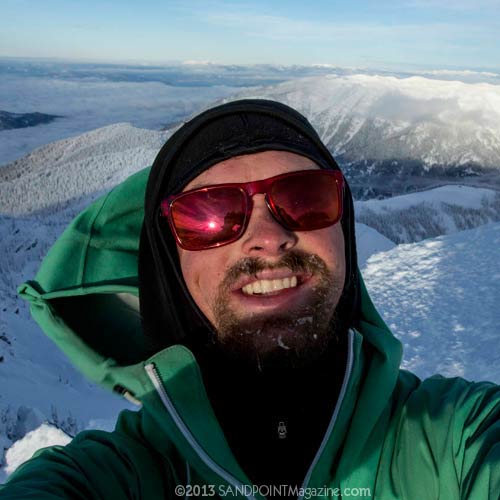
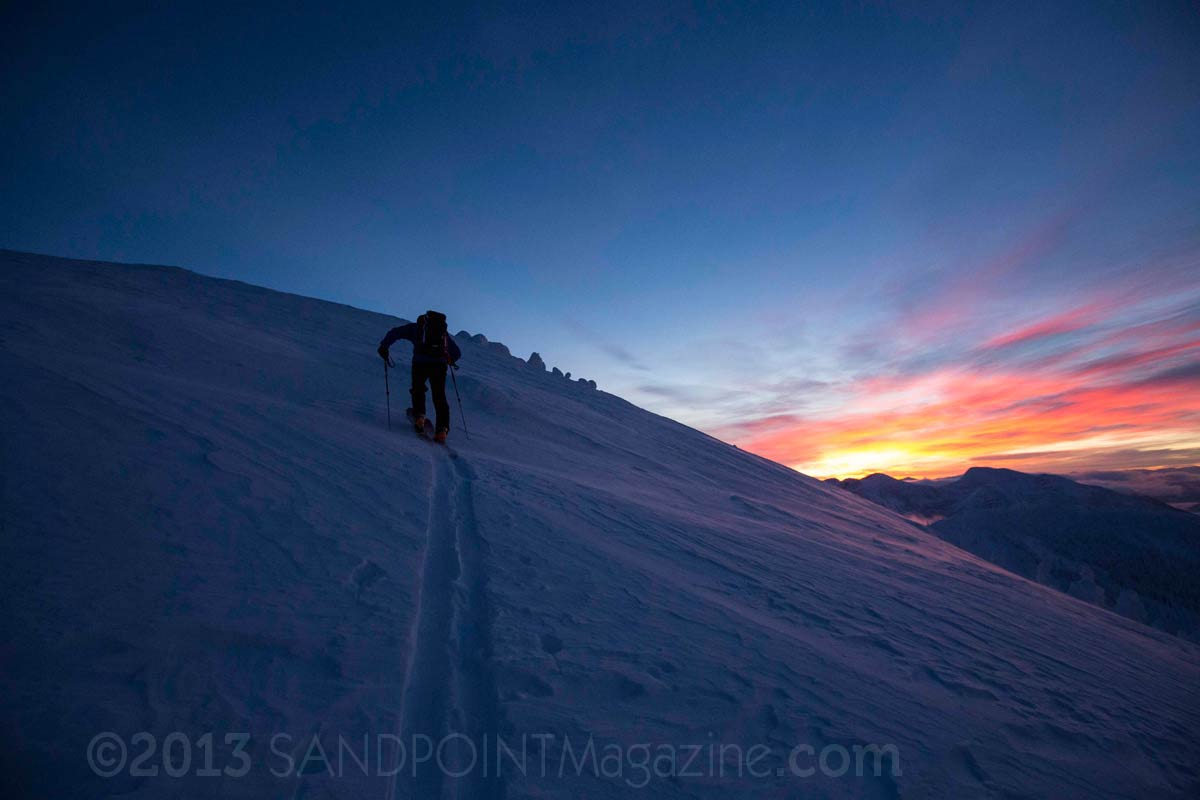
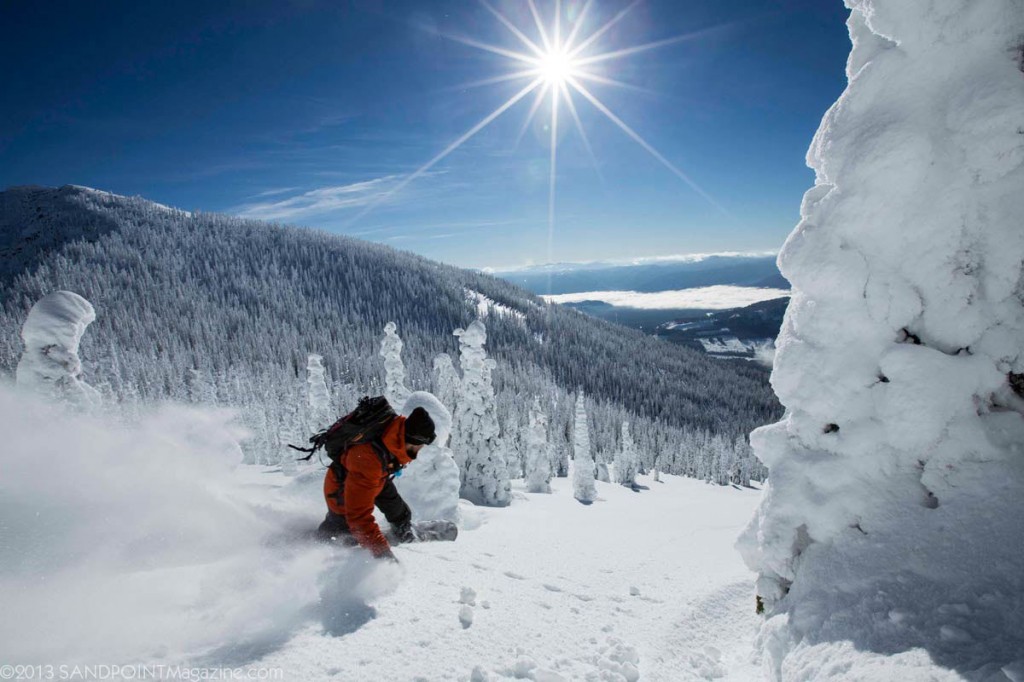
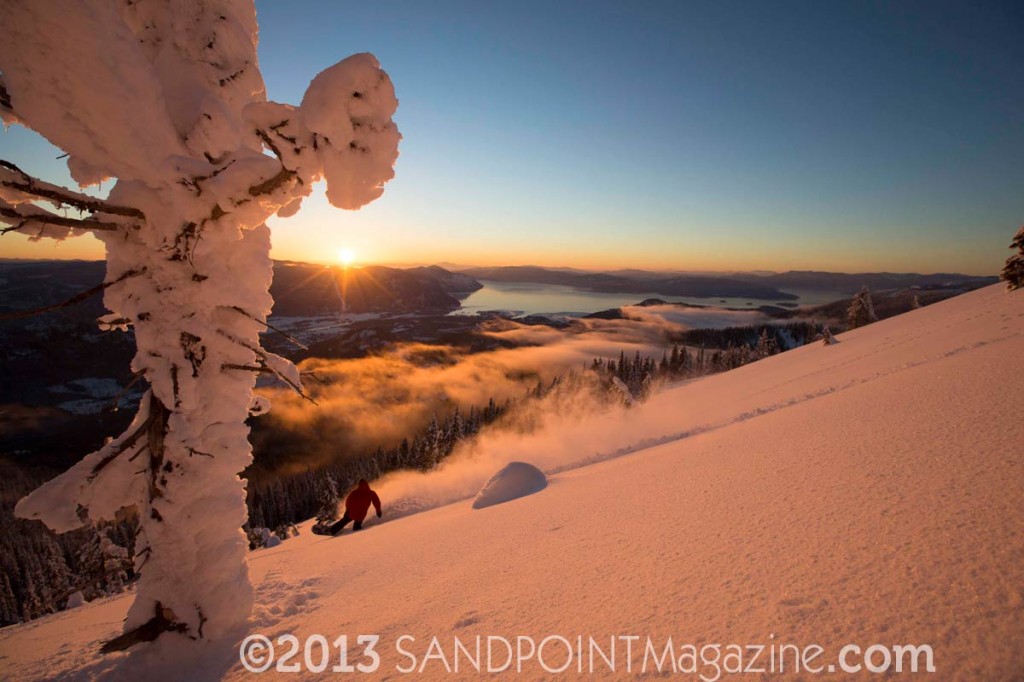
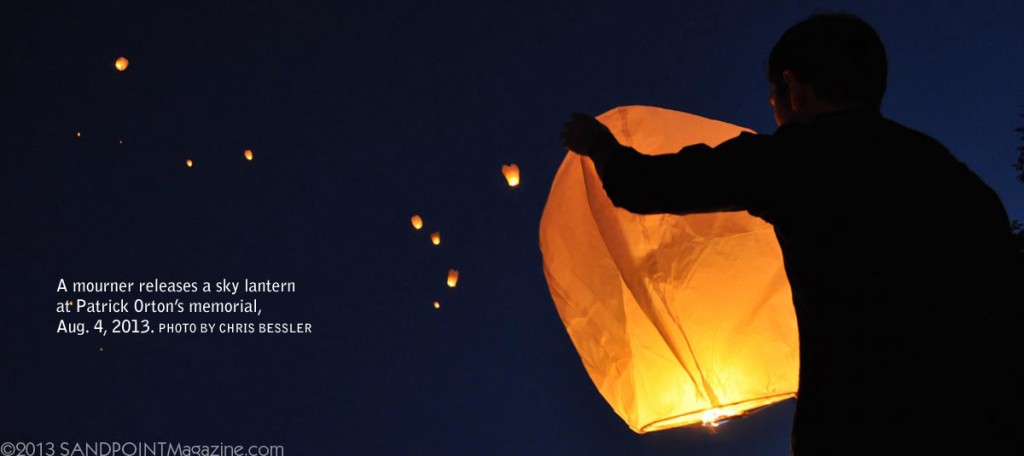



My son is researching local photographers and this article about Patrick Orton came up. Such an amazing person, life, and photographs! I called your mom today to tell her since I know her already from my mom’s. Love to the Orton family and good job Sandpoint Magazine always.